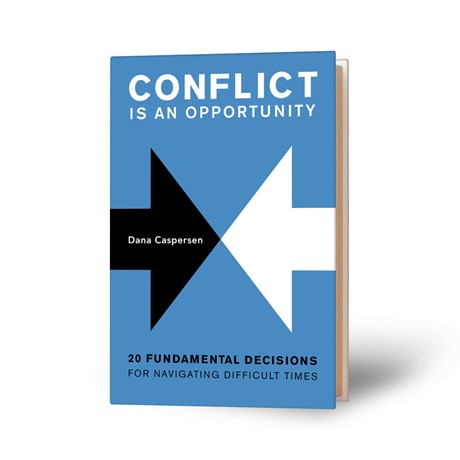Conflict gets a bad rap. Most of us hate it.
A workplace can come to feel poisoned by conflict. When we don’t find useful ways to address important conflicts, they simmer exhaustingly or boil into damaging storms. We often end up creating unsustainable workarounds to avoid dealing with a conflict, or we engage in adversarial battles that damage relationships and collaborations. But it doesn’t have to be this way.
Conflict is a signal of possibility–an opportunity for constructive change. To address conflicts in a way that makes that change more likely to happen, the right people need to be at the table. Make sure you’re clear on who is involved in the conflict and who needs to be involved in the conversation in order to find a useful way forward.
Notice if you or others are perpetuating the conflict by avoiding useful conversation with the person or people at the heart of the matter. Notice, too, if the conflict is being escalated by dragging in people who are not involved. If you see that important voices have been missing from the conversation so far (especially those that you or others are not accustomed to or don’t want to hear), figure out why they are missing and what would make it possible for them to be present.
Often, on interpersonal or structural levels, when voices have been habitually or historically dismissed, there is momentum that works against them entering the conversation in a meaningful way. If you see a pattern of dismissal in place in your situation, question it. Consider why that pattern is in place and take active steps to counter it, even if there is resistance or awkwardness because the pattern of silencing is woven deeply into the status quo. The status quo can change.
Sometimes you or others might be tempted try to manage a conflict in a one-sided way– for example, pushing through strategies that primarily benefit one side, superficially tamping down a conflict enough to just keep getting by, or creating ad hoc work-arounds behind the scenes to avoid dealing with others involved in the conflict. However, these kinds of approaches leave the rot in the base and tend to create unstable situations full of resentment, stress, and wasted opportunity. Try something else; practice normalizing conflict.
If you see that useful conversation is being avoided or important voices are missing, try bringing up the topic, to the right people, not as a way to point out failure, but as a way to collectively notice the current mechanisms of the situation and what you can work together to change. Often, people have the sense that conflict is bad, abnormal, or a sign of incompetence. The strategy of avoiding or not acknowledging conflict can become a way to try to save face or an ineffective attempt to reduce stress and survive difficult situations. Instead, practice seeing conflict as a normal and potentially useful part of any individual or group relationship.
Frame the process of looking at who is involved in a conflict as the action of gathering important information to understand the situation. Help others do the same through the way that you raise the topic.
For example:
“I get the sense that this is not just an engineering department issue. It seems like there are other people who need to be involved in this conversation so that we can figure out what to do. Which voices or input do you think are missing at the moment?”
or
“I’m being affected by this conflict and I’d like to be part of the conversation happening around this issue.”
or
“It seems to me that the proposals being made don’t take into account the impact on everyone involved. I’d like to open up this dialogue to include a broader range of viewpoints so that our decisions can be better informed.”
When a conflict is worsened because important conversations are not happening, clearly naming the people and issues at the heart of the conflict can help clarify the focus. And, when people in the center of the conflict are wound up so tightly in each other that they can’t see the broader impact of their actions, consciously opening the view to include others who are affected can help bring new options to light.
Whether you are running a business or working as an employee, building up a practice of seeing more broadly in a conflict is an invaluable skill. Widening your attention to ask who is involved and who is impacted by a conflict can help you to get to the heart of a conflict, find out what matters, and create pathways forward that will be effective and sustainable.
Conflict doesn’t have to be a drain on energy and morale. It can be a source of learning, adaptation, and stronger working relationships. By approaching conflict with curiosity, openness, and a willingness to include the necessary voices, businesses of any size can turn points of tension into opportunities for growth. The more conflicts are handled in ways that address core issues rather than just symptoms, the more resilient and dynamic a business will become.
Find a Home-Based Business to Start-Up >>> Hundreds of Business Listings.


















































